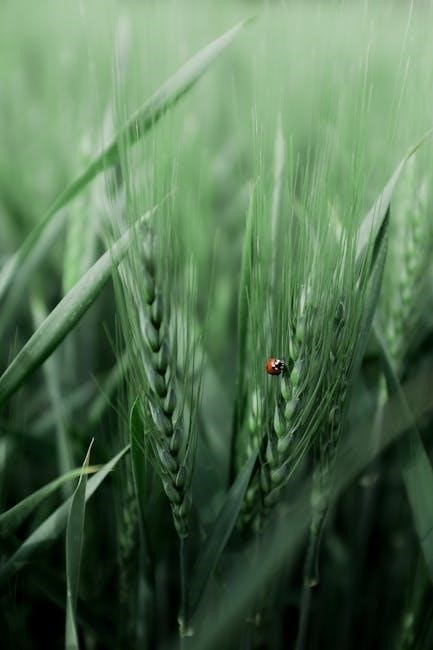Animal and plant cells are eukaryotic, serving as life’s fundamental building blocks. They share common structures like mitochondria, ribosomes, and a nucleus, but differ in unique features like chloroplasts in plants and centrioles in animals. Both are essential for survival and growth, with visible details under a microscope, including cell walls and vacuoles in plants.
1.1 Basic Definitions
Cells are the smallest structural and functional units of living organisms, serving as the basic building blocks of life. Eukaryotic cells, which include both plant and animal cells, are characterized by the presence of a nucleus and various organelles. Plant cells are distinguished by features like a rigid cell wall, chloroplasts for photosynthesis, and large vacuoles for storage. Animal cells, in contrast, lack a cell wall and chloroplasts but contain centrioles, which aid in cell division. Both types of cells share essential components such as the cell membrane, cytoplasm, and mitochondria, which are vital for energy production and cellular functions. Understanding these fundamental definitions is crucial for exploring the intricacies of plant and animal cell structures and their unique roles in biology.
1.2 Importance of Studying Cells
Studying cells is fundamental to understanding life’s basic mechanisms. Cells are the building blocks of all living organisms, and their structures and functions reveal how life operates at its most basic level. By exploring plant and animal cells, students gain insights into biology’s core principles, such as growth, reproduction, and energy production. This knowledge is essential for advancing fields like medicine, agriculture, and biotechnology. Worksheets and educational tools help students visualize and compare cell structures, fostering critical thinking and scientific literacy. Understanding cells also promotes appreciation for the complexity and diversity of life, inspiring further exploration in biology and related disciplines. This foundation is crucial for addressing real-world challenges and innovations in health and environmental science.
1.3 Overview of Cell Structures
Plant and animal cells share essential structures like the cell membrane, cytoplasm, and nucleus, which are vital for survival. The cell membrane regulates what enters and exits, while the cytoplasm houses metabolic activities. The nucleus controls genetic material, directing cell functions. Plant cells uniquely feature cell walls for support, chloroplasts for photosynthesis, and large vacuoles for storage. Animal cells, however, contain centrioles that aid in cell division. These structural components work together to maintain cellular integrity and enable specialized functions. Understanding these elements is crucial for grasping how cells operate and sustain life. Worksheets and diagrams are invaluable tools for visualizing and comparing these structures, helping students build a solid foundation in cellular biology and its practical applications in various scientific fields.

Similarities Between Plant and Animal Cells
Both plant and animal cells share essential organelles like mitochondria, ribosomes, and a nucleus, enabling common functions such as energy production and genetic control. These similarities highlight their shared evolutionary origins and fundamental biological processes.
2.1 Common Organelles
Plant and animal cells share several key organelles that are vital for their survival and function. The cell membrane, present in both, regulates the movement of substances in and out. The cytoplasm serves as the medium for chemical reactions, while mitochondria generate energy through ATP production. Both cells contain ribosomes, responsible for protein synthesis, and a nucleus, which houses genetic material. These shared structures emphasize their evolutionary relationship and underscore the foundational processes common to all eukaryotic cells, such as metabolism, growth, and reproduction.
2.2 Shared Functions and Processes
Both plant and animal cells perform essential functions necessary for survival. They both undergo cell division to reproduce and grow, though the process differs slightly. Metabolism occurs in both, with mitochondria generating ATP for energy. Protein synthesis is carried out by ribosomes, while the cell membrane regulates material transport. DNA replication and transcription are common processes, enabling genetic continuity. Both cells maintain homeostasis and respond to stimuli. These shared functions highlight their evolutionary kinship and the universal cellular processes that sustain life. Understanding these shared mechanisms is crucial for comparing and contrasting plant and animal cells effectively.
2.3 Evolutionary Connections
Plant and animal cells share a common ancestry, as both are eukaryotic and trace back to ancient cells. Their structural similarities, like the nucleus and mitochondria, reflect this evolutionary kinship. Over time, plants and animals diverged, adapting to different environments and developing unique features. Despite these differences, both cell types maintain fundamental processes such as metabolism and DNA replication. The shared eukaryotic origin explains why many organelles and functions are conserved across species. This evolutionary connection underscores the unity of life at the cellular level, providing insights into how diverse organisms have evolved from common beginnings. These similarities and differences are vital for understanding biological diversity and the history of life on Earth.

Differences Between Plant and Animal Cells
Plant cells have cell walls, chloroplasts, and larger vacuoles, while animal cells lack these, having centrioles and lysosomes instead. These differences reflect their unique functions and structures.
3.1 Unique Organelles in Plant Cells
Plant cells contain distinct organelles that differentiate them from animal cells. The cell wall, composed of cellulose and pectin, provides structural support and protection. Chloroplasts, present in plant cells, are essential for photosynthesis, converting sunlight into energy. These organelles contain chlorophyll, giving plants their green color. Additionally, plant cells often have a large central vacuole, which stores water, nutrients, and waste, maintaining cell turgidity. Some plant cells also contain amyloplasts, specialized organelles for starch storage. These unique structures enable plants to perform functions like photosynthesis and maintain rigidity, distinguishing them from animal cells. These organelles are fundamental to plant cell function and survival, highlighting their specialized roles in the natural world.
3.2 Unique Organelles in Animal Cells
Animal cells possess unique organelles that are not found in plant cells. One of the most notable is the centriole, which plays a crucial role in cell division by organizing microtubules during spindle formation. Another distinct feature is the presence of lysosomes, membrane-bound organelles responsible for cellular digestion and recycling. These organelles contain digestive enzymes that break down waste materials and foreign substances. Additionally, animal cells often have a more prominent cell membrane that facilitates movement and communication. These specialized structures enable animal cells to perform functions like rapid cell division and intracellular digestion, which are essential for the survival and adaptability of animal organisms. These organelles highlight the unique biological processes that distinguish animal cells from their plant counterparts.
3.3 Structural and Functional Variations
Structural and functional variations between plant and animal cells are evident in their shapes, organelles, and adaptability. Plant cells are generally rigid due to their cell walls, while animal cells are more flexible and can move freely. Plant cells often have larger vacuoles for storage, whereas animal cells have smaller, numerous vacuoles. Animal cells also lack chloroplasts but may contain lysosomes for digestion. These differences reflect their environments and roles. Plant cells are adapted for stability and photosynthesis, while animal cells prioritize mobility and rapid responses. Such variations highlight how each cell type is specialized to meet the unique demands of their respective organisms, showcasing nature’s remarkable adaptability.

Key Organelles in Plant and Animal Cells
Plant and animal cells contain essential organelles like the nucleus, mitochondria, and cell membrane, each with unique roles in maintaining cellular function and overall organism health effectively.
4.1 Cell Membrane and Its Functions
The cell membrane, also known as the plasma membrane, is a semi-permeable structure that surrounds the cell, regulating the movement of substances in and out. It is composed of a phospholipid bilayer with embedded proteins, enabling selective permeability. This membrane protects the cell’s internal components while allowing essential nutrients to enter and waste products to exit. It plays a crucial role in maintaining cellular homeostasis and facilitating communication between the cell and its environment. In both plant and animal cells, the cell membrane is vital for survival, ensuring the proper balance of materials necessary for cellular functions. Its flexibility allows for processes like endocytosis and exocytosis, which are critical for cell growth and interaction.
4.2 Cytoplasm and Its Role
Cytoplasm is the jelly-like substance within a cell, surrounding the organelles and filling the space between the cell membrane and the nucleus. It consists of cytosol, a liquid medium, and organelles like ribosomes, lysosomes, and mitochondria. Cytoplasm plays a vital role in cellular metabolism, serving as the site for many chemical reactions, including glycolysis, the first step in cellular respiration. It also aids in the movement of materials within the cell, supports organelle functions, and maintains cell shape. In plant cells, cytoplasm helps regulate turgor pressure, while in animal cells, it facilitates processes like cell signaling and cytokinesis. Its dynamic nature allows it to adapt to cellular needs, making it essential for overall cell function and survival.
4.3 Nucleus and Its Importance
The nucleus, often referred to as the control center of eukaryotic cells, houses most of the cell’s genetic material in the form of DNA, organized into chromosomes. It is enclosed by a double membrane known as the nuclear envelope, which regulates the passage of materials through nuclear pores. This structure ensures the protection of genetic information and controls access to it. The nucleus directs cell growth, metabolism, and reproduction by managing gene expression and the transmission of genetic information during cell division. It plays a critical role in processes such as mitosis and meiosis, ensuring the accurate distribution of genetic material to daughter cells. The nucleus also contains the nucleolus, where ribosome synthesis begins, essential for protein production. Its functions are vital in both plant and animal cells, making it indispensable for cellular integrity and function.
4.4 Mitochondria and Energy Production
Mitochondria, often called the “powerhouses” of eukaryotic cells, are essential for energy production through the process of cellular respiration. Found in both plant and animal cells, these organelles generate ATP (adenosine triphosphate), the primary energy currency of the cell. Mitochondria consist of a double membrane structure, with the inner membrane folded into cristae to increase surface area for ATP synthesis. The matrix contains enzymes that facilitate the citric acid cycle, a key step in energy production. This process converts glucose into usable energy, supporting cellular functions such as growth, repair, and transport. Without mitochondria, cells would lack the energy required to sustain life, making them indispensable for both plant and animal survival. Worksheets often highlight mitochondria to emphasize their critical role in cellular metabolism and energy supply.
4.5 Chloroplasts and Photosynthesis
Chloroplasts are specialized organelles found in plant cells and some algae, playing a central role in photosynthesis. These organelles contain the pigment chlorophyll, which captures sunlight to power the conversion of carbon dioxide and water into glucose and oxygen. Structurally, chloroplasts have a double membrane and a fluid-filled stroma, with thylakoids forming light-capturing structures. Photosynthesis occurs in two stages: the light-dependent reactions in the thylakoid membranes and the light-independent Calvin cycle in the stroma. This process is vital for plant growth and energy production, supporting life on Earth by providing oxygen and organic compounds. Worksheets often include chloroplast diagrams to help students visualize their role in sustaining plant life and the food chain.
4.6 Vacuoles and Their Functions
Vacuoles are membrane-bound organelles present in plant and animal cells, though they are more prominent in plants. In plant cells, large vacuoles store water, nutrients, and waste products, contributing to cell turgidity and rigidity. They also play a role in maintaining cell shape and storing pigments. In animal cells, vacuoles are smaller and less prominent, often involved in waste removal and cellular digestion. Worksheets typically include diagrams to highlight these differences, aiding students in understanding their roles. Functions such as storage, osmoregulation, and cell structure emphasize their importance in cellular operations, making them a key focus in educational materials for cell biology studies.
4.7 Centrioles and Cell Division
Centrioles are small, cylindrical organelles found in animal cells, playing a crucial role in cell division. They are located near the nucleus and form spindle fibers during mitosis and meiosis, ensuring proper chromosome segregation. Worksheets often highlight their importance in organizing microtubules, which are essential for dividing cells. In plant cells, centrioles are absent, and other structures manage cell division. Their function is vital for maintaining genetic stability, as misaligned chromosomes can lead to cellular abnormalities. Educational resources emphasize their role in animal cell biology, while plant cells rely on alternative mechanisms for division, showcasing evolutionary adaptations in cellular processes.

Teaching Methods for Cell Education
Engaging methods like labeling diagrams, Venn comparisons, and hands-on activities enhance learning. Interactive worksheets and visual tools help students grasp cell structures and functions effectively and comprehensively.
5.1 Labeling Diagrams
Labeling diagrams are a fundamental tool in cell education, allowing students to identify and understand the structures of plant and animal cells. By providing detailed diagrams of both cell types, educators can guide students in accurately labeling key organelles such as the nucleus, mitochondria, chloroplasts, and vacuoles. This method enhances visual learning and helps students recognize the similarities and differences between plant and animal cells. Worksheets with labeled diagrams also serve as a reference for students to review and reinforce their knowledge; Interactive labeling activities, whether physical or digital, encourage active participation and make learning engaging. Over time, this practice improves students’ ability to describe cellular functions and structures confidently.
5.2 Venn Diagrams for Comparison
Venn diagrams are an effective visual tool for comparing plant and animal cells, helping students identify shared and unique features. By categorizing organelles such as mitochondria, ribosomes, and the nucleus under “both,” and cell walls, chloroplasts, and vacuoles under “plant,” and centrioles and lysosomes under “animal,” students can visually grasp the differences and similarities. This method enhances understanding of cellular biology and promotes critical thinking. Worksheets incorporating Venn diagrams encourage students to organize information logically, fostering a deeper appreciation for how these cells function and evolve. Such activities not only simplify complex concepts but also make learning interactive and engaging, fostering scientific curiosity and a solid foundation for further study.
5.3 Hands-On Activities
Hands-on activities provide students with interactive and engaging ways to explore plant and animal cells. For instance, creating 3D cell models using materials like noodles, glue, and colored paper allows students to visualize and label cell structures. They can craft plant cell walls with cardboard and animal cell membranes with plastic wrap, adding details like mitochondria (beads) and chloroplasts (green paper cutouts). Microscope observation activities let students examine real cells, fostering a connection between theory and practice. Additionally, role-playing cellular processes, such as simulating photosynthesis or cell division, enhances understanding. These activities make learning immersive, helping students retain information better than passive methods. They also encourage teamwork and creativity, making cell education both fun and effective for all learners. Such practical exercises are invaluable for developing a strong foundation in cellular biology.
5.4 Interactive Worksheets
Interactive worksheets are dynamic tools designed to engage students actively in learning about plant and animal cells. These worksheets often include features like drag-and-drop labeling, fill-in-the-blank exercises, and matching games. For example, students can drag labels like “mitochondria” or “chloroplast” to their correct positions on cell diagrams. Some worksheets incorporate clickable animations that reveal answers or provide immediate feedback, enhancing self-assessment; Additionally, interactive worksheets may include quizzes with auto-grading, allowing students to track their progress. These resources cater to diverse learning styles, making cell education accessible and enjoyable. They also encourage critical thinking and problem-solving, helping students connect theoretical knowledge with practical application. Overall, interactive worksheets are a modern and effective way to teach complex cellular concepts in an engaging manner, fostering deeper understanding and retention.

Worksheets as Educational Tools
Worksheets are invaluable educational tools for teaching plant and animal cells. They provide structured activities, enhancing student engagement and understanding of cellular structures and functions, making learning interactive and effective.
6.1 Benefits of Using Worksheets
Worksheets on animal and plant cells offer numerous educational benefits. They provide structured activities that enhance engagement and understanding of cellular structures. By labeling diagrams, matching terms, and answering questions, students develop critical thinking and retention skills. Worksheets also facilitate self-paced learning, allowing students to explore concepts independently. They serve as valuable assessment tools, helping teachers gauge comprehension and identify areas needing review. Interactive elements, such as Venn diagrams and crossword puzzles, make learning fun and dynamic. Additionally, worksheets encourage hands-on participation, fostering a deeper connection to the material. Their accessibility and versatility make them ideal for diverse learning environments, ensuring students gain a solid foundation in cell biology. Worksheets are thus a cornerstone of effective science education.
6.2 Designing Effective Worksheets
Creating effective worksheets for teaching animal and plant cells requires careful design to ensure engagement and understanding. Begin by including scientifically accurate diagrams of both cell types, clearly labeled for easy identification. Incorporate a variety of activities, such as matching terms to definitions, filling in the blanks, and crossword puzzles, to cater to different learning styles. Use color and visual aids to make the content visually appealing. Ensure instructions are clear and concise, guiding students through each task. Interactive elements, like Venn diagrams to compare plant and animal cells, enhance learning. Additionally, include fun facts or trivia to spark curiosity. Organize the layout for easy navigation, avoiding clutter. Finally, incorporate feedback mechanisms to help students assess their progress. These design elements ensure worksheets are both educational and enjoyable, fostering a deeper grasp of cellular biology.
6.3 Examples of Worksheet Exercises
Effective worksheets for teaching animal and plant cells often include a variety of engaging exercises. One common activity is labeling diagrams of plant and animal cells, where students identify and name organelles like mitochondria, chloroplasts, and the cell nucleus. Another exercise involves creating Venn diagrams to compare and contrast plant and animal cells, highlighting similarities and differences. Matching games, where terms like “cell wall” or “centrioles” are paired with their functions, reinforce vocabulary. Fill-in-the-blank sentences and crossword puzzles also test comprehension. Additionally, students can draw and label their own cell models, fostering creativity and understanding. These exercises cater to different learning styles, ensuring a comprehensive grasp of cellular structures and their roles; Interactive and diverse, they make learning about cells both enjoyable and effective;

Assessing Student Understanding
Assessment of student understanding involves quizzes, tests, and project-based evaluations. These methods ensure students can identify, compare, and explain plant and animal cell structures and their functions accurately.
7.1 Quizzes and Tests
Quizzes and tests are essential tools for assessing student understanding of plant and animal cells. They help evaluate students’ ability to identify and label cell structures, such as the nucleus, mitochondria, and chloroplasts. These assessments often include multiple-choice questions, short-answer responses, and diagram labeling exercises. Regular quizzes ensure students retain information and understand key concepts, like the functions of organelles and the differences between plant and animal cells. Tests provide a comprehensive evaluation of knowledge and can highlight areas where students need additional support. By incorporating visual elements, such as diagrams, quizzes and tests become more engaging and effective in measuring learning outcomes. This approach ensures a thorough understanding of cellular biology and prepares students for advanced topics.
7.2 Project-Based Assessments
Project-based assessments offer a hands-on approach to evaluating student understanding of plant and animal cells. Students can create detailed cell models using materials like clay, noodles, or paper, labeling each organelle and explaining its function. These projects encourage creativity and critical thinking while reinforcing knowledge of cellular structures. For example, students might design a plant cell model with a cell wall, vacuole, and chloroplasts, or an animal cell with centrioles and lysosomes. Such assignments allow teachers to assess both accuracy and the ability to apply concepts. Additionally, group projects foster collaboration and communication skills, making learning interactive and engaging. This method provides a comprehensive evaluation of students’ grasp of cellular biology beyond traditional tests.
7.3 Peer Review and Collaboration
Peer review and collaboration are valuable tools for enhancing student learning in cell education. By working in pairs or small groups, students can review each other’s worksheets, providing constructive feedback on accuracy and completeness. This fosters a collaborative environment where students learn from one another and gain a deeper understanding of plant and animal cells. Encouraging students to explain their answers to peers promotes clear communication of scientific concepts. Teachers can facilitate this by assigning group activities, such as labeling diagrams or comparing cell structures, which reinforce teamwork and engagement. Peer discussions also help identify common misconceptions, allowing for targeted clarification. This approach not only strengthens interpersonal skills but also ensures a more comprehensive grasp of cellular biology. Collaboration makes learning interactive and inclusive, benefiting all participants.

Animal and plant cell worksheets are invaluable tools for fostering understanding and engagement in cellular biology. Interactive learning enhances students’ grasp of cell structures and functions effectively.
8.1 Summary of Key Points
Animal and plant cells share foundational structures like the nucleus, mitochondria, and cell membrane, essential for survival. Plant cells uniquely feature chloroplasts and a cell wall, enabling photosynthesis and structural support. Animal cells, conversely, have centrioles aiding in cell division. Worksheets and interactive tools bridge learning gaps, making complex cellular concepts accessible. Labeling diagrams, Venn comparisons, and hands-on activities enhance engagement. Worksheets specifically highlight shared and distinct organelles, fostering a deeper understanding. Effective teaching methods, including quizzes and projects, assess student comprehension. Collaborative efforts and peer reviews further enrich the educational experience. These strategies collectively ensure a comprehensive grasp of cellular biology, inspiring further exploration and appreciation for life’s microscopic marvels.

8.2 Encouraging Further Exploration
Encouraging students to explore beyond worksheets fosters a deeper appreciation for cellular biology. Interactive activities, such as creating cell models or conducting microscope experiments, can spark curiosity. Project-based learning, like researching specific organelles or their functions, enhances engagement. Utilizing online resources, such as virtual cell tours or simulations, provides immersive learning experiences. Encouraging students to design their own cell-themed projects or presentations can further solidify their understanding. By integrating hands-on and digital tools, educators can inspire students to delve into the fascinating world of cells, fostering a lifelong interest in science and discovery. This approach not only reinforces classroom lessons but also prepares students for advanced scientific exploration.

8.3 Final Thoughts on Cell Education
Effective cell education is foundational for understanding life sciences. Worksheets on plant and animal cells serve as invaluable tools, making complex concepts accessible and engaging. They encourage active learning, fostering curiosity and scientific literacy. By integrating labeled diagrams, Venn comparisons, and hands-on activities, educators can cater to diverse learning styles. These resources not only reinforce theoretical knowledge but also inspire students to explore further. Encouraging interactive and creative approaches ensures a deeper grasp of cellular biology. As students gain insight into the microscopic world, they develop a stronger appreciation for the intricacies of life. Investing in quality educational tools and methods is essential for nurturing future scientists and thinkers, ensuring a bright future for scientific discovery and innovation.
